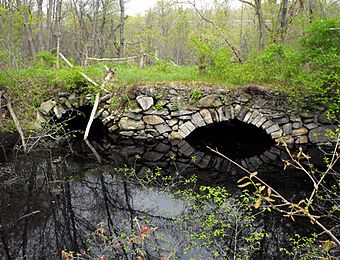Double-arch Sandstone Bridge facts for kids
Quick facts for kids |
|
|
Double-arch Sandstone Bridge
|
|

Sands Bridge South Side
|
|
| Location | Methuen, Massachusetts |
|---|---|
| Built | 1835 |
| MPS | Methuen MRA |
| NRHP reference No. | 84002326 |
| Added to NRHP | June 20, 1984 |
The Double-arch Sandstone Bridge, also known as the Sands Bridge, is a very old bridge in Methuen, Massachusetts. It crosses the Spicket River on Hampshire Road. This bridge is special because it was built using a method called "dry stone." This means the stones were carefully placed together without any mortar (a type of cement) to hold them.
Parts of the bridge might be as old as 1735. It was an important path for people traveling between Methuen and Salem, New Hampshire.
Contents
What is the Sands Bridge?
The Sands Bridge is a historic arch bridge. It's called "double-arch" because it has two main arch shapes. The dry stone method used to build it is very old. It shows how people built strong structures long ago using only natural materials.
How Was the Sands Bridge Built?
The area where the bridge stands was once a marshy part of the Spicket River. People used to cross it by horse or cart. The town records from 1730 show there was a simple wooden bridge here first. This wooden bridge needed a lot of repairs.
In 1835, a stronger stone arch bridge was built to replace the wooden one. Workers built strong supports on each side of the river. Then, they made a wooden frame shaped like the bottom of the bridge's arch. The stones were carefully placed on this frame. No mortar was used between the stones.
After the stones were in place, the bridge was filled with rubble and dirt. This material would settle and press against the stone supports. Finally, the wooden frame was removed. If built correctly, a stone arch bridge can last a very long time. However, the Sands Bridge was not perfectly built. Pictures from the late 1800s show that a main stone, called the keystone, had already slipped.
When Was the Sands Bridge Used?
The Sands Bridge was used for many years. It helped people and goods move between towns. But in 1963, the Spicket River was moved to a new path. Also, a big highway called Interstate 93 was built nearby. Because of these changes, the Sands Bridge was no longer needed for traffic.
Even though it was no longer used, the bridge is still important. On June 20, 1984, it was added to the National Register of Historic Places. This list includes important buildings, sites, and objects that are worth preserving.
What is the Bridge's Condition Today?
In May 2009, the Sands Bridge was in very bad shape. It was in danger of falling apart. Officials in Methuen wanted to fix the bridge and create a park around it. Their plans included walking paths, places to view the bridge, and a parking lot.
However, as of September 2012, the bridge had fallen into even worse condition. City officials had not taken action to repair or care for the bridge. It remains a historical landmark that needs attention.
Images for kids





